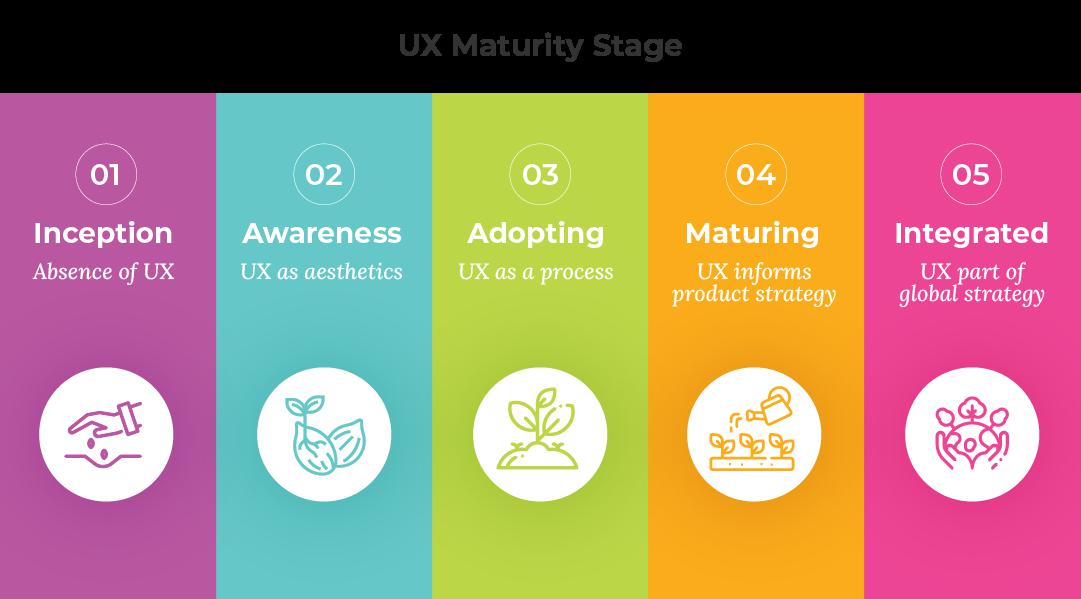Getting clear on where your organization lands when it comes to understanding the value of user experience (UX) design and research can help you determine what your next steps should be to improve upon your digital products and services.
Making this type of UX assessment is not a new exercise. In fact, if you look up “UX Maturity Scale” in a search engine, you’ll see that many of the same images and scales appear. Generally, it’s widely accepted that there are five to six key stages in any organization’s UX Maturity. These stages range from “Uninterested” to “Embedded”, or from “Beginning” to “Exceptional,” and no matter where you might land, the differences between each stage are relatively distinct.
What Is a UX Maturity Scale?
Let’s begin by defining UX, or user experience. UX does not simply refer to the “look and feel” of an application or digital product––and actually, looking at UX from this perspective may mean that you are on Stage 1 or 2 of the UX Maturity scale (we will get into this in a minute). We really like the Nielson Norman Group’s definition of UX:
“User experience” encompasses all aspects of the end-user’s interaction with the company, its services, and its products.
It’s crucial to remember that every touchpoint and interaction a customer or user has with your business and its products and services is an “experience” that should be scrutinized and optimized. UX researchers and designers (as well as service designers and anyone practicing human-centered design) can help you do this. And a UX Maturity Scale will point to how ready your organization is to tackle this type of work. It will also help you determine if UX, as a tool and discipline, is recognized and/or valued by the organization’s executives and teams.
The diagram above, adapted from a great UX Collective article by Luky Primadani, is a great example of a standard UX Maturity Scale. It includes five stages, each of which showcase a different level of UX maturity that an organization may fit into. We also like the Design Maturity Scale created by the Design Management Institute and the UX Maturity Scale by UX Planet.
Stage 1, (in this model called “Inception”) refers to a marked absence of UX, and possibly a lack of understanding within the organization about what UX design and research are, and how they are used. If this is where your business lands, don’t panic! There are several ways to get started with UX (which we explain at more length below).
Stage 2, sometimes referred to as the “Awareness” or “Interested” stage, demonstrates that a company has heard of UX, but that they may not have a full understanding of how powerful UX design and research can be. In this context, UX might be viewed simply as “aesthetics”, a visual tool or technique to make products and apps “look good” above all else––and there is probably very little buy-in at this stage from executives (and thus, very little funding). This means that your team is probably viewing UX design as UI (user interface) design. These terms are commonly used interchangeably, but they relate to different aspects of the user experience. As well, at this stage, it is very unlikely that your organization is conducting any research with its users.
View this post on Instagram
Learn more about the differences between UX and UI design on our Instagram page…
Stage 3 is the “Invested” or “Adopting” phase of the UX Maturity scale. At this point in a five-stage UX scale, an organization has decided to invest in the UX process in more depth. UX research is being used more frequently to drive product, feature, and service decisions. There is most likely an allocated budget for UX, as well as new UX hires and wider executive/stakeholder buy-in. However, here, your UX and UI designers may be more junior, and they may also report to a Director of Engineering or a Product Manager, with no UX governance in place. As for research, at Stage 3, a company is likely using validation research (usability testing) once their product has already been designed––essentially testing with users to get feedback and make small improvements. It’s unlikely a company is engaging in exploratory or generative research with users, meaning they aren’t conducting discovery research in the “fuzzy front end” of design to really understand the user’s needs and challenges.
By Stage 4, an organization is clearly “Committed” to and “Engaging” with UX design and research. In other words, as the scale above shows, the company is maturing in its UX capacity. Design and UX strategy are now key components of decision making when it comes to products and services. At this stage, you likely have a team in place, with some management or director level roles for UX. You are also conducting both discovery research and validation research (testing) with end users. The company might also be holding co-design workshops, and might have a longer discovery and definition phase before diving straight into design and implementation.
And Stage 5 represents an organization with an integrated UX strategic culture. The ultimate goal! A holistic, user-centred design process has been developed and is widely acknowledged and applied across project teams, products, and services. Executive leadership in the form of VP of Experience or Chief of Design likely exists.
Where does your business fit?
Here are some actionable next steps for your organization, based on where you might currently land on the UX Maturity Scale.
Absent or Early UX Maturity (Stages 1 or 2)
You’re ready to introduce UX strategy and design into your organization. At this level, UX is either wholly absent at your company, or you are just dipping your toes into it. As mentioned above, it’s possible that teams and execs view UX as solely fulfilling an aesthetic role, which means few resources are invested in it. How can you get started?
Begin by establishing some user-centered goals for your organization. Create an action plan that begins with listening to your client or user. These initial conversations are critical to the foundation in which your product strategy is built upon.
A great way to get started is with ethnographic customer/user research. When was the last time you spoke to your users? Conducting one-one-one, in-depth interviews with customers/users gives you the opportunity to explore their true needs, motivations, and behaviours. What challenges do they face using and interacting with your product or service? Interviewing (and similar methods, like observations, surveys, and diary studies) during the early stages of UX maturity can be great for uncovering major pain points and finding opportunities to improve.
Also, consider outsourcing your UX to the pros! An experienced consulting firm (hello, Outwitly here!) can help you establish best practices and processes for improving your product’s user experience. UX consultants can also demonstrate how your engineering team can integrate with design and research seamlessly and in an agile way.
An Invested, Mid-Level UX Maturity (Stages 3–4)
So your organization understands the importance of investing in UX, and time and resources are being diverted to user research, usability testing, and some design strategy. You are starting to really reap the benefits of UX design and you’re ready for more. The good news? This practice of allowing UX findings to impact organizational decision making is only going to continue elevating your business (and your revenue!)
Now, keep the momentum going. Sharing high-level insights from discovery research and testing across the organization is essential for continued collaboration and transparency. Design artifacts like customer journey maps and personas are great tools to communicate and champion UX strategy across the organization and between departments. This will keep everyone on the same page when it comes to making strategic product or feature decisions.
At this stage, you may be engaging in some research (and are probably well-versed in usability testing), so now is the time to start investing more heavily in that front-end discovery research that is more exploratory in nature. This will help you identify opportunities for innovation and areas where you can delight your users and customers. You may also want to solidify and standardize your design and research processes and create a playbook for how and when research should be conducted, as well as create design pattern libraries and ensure there is a consistent design language between all of your products and services.
As well, involve your designers early in the product development (and product definition) phases. Your company should really start to see them as strategic partners and facilitators, versus only involving them once product management and executive teams have already decided what the product and features will be.
Finally, ensure that all studies, test results, and best practices are readily available to all. Like the journey maps mentioned above, displaying research insights in accessible spaces (physical or virtual) means your team can always access them for future decision making. Return on investment (ROI) increases when everyone is on the same page and implementing UX design into daily processes.
An Integrated and Mature UX culture (Stages 4–5)
So, your organization fully and holistically embraces UX and design principles! This means your C-suite advocates for UX and design, and the culture of your workplace is human-centered and design forward. Your business follows an iterative design process that involves ethnographic research, prototyping, and user testing. Bravo!
What’s next? Well, continue spreading this human-centered approach across your organization and between departments. Never lose sight of the interdisciplinary nature of design. Continue to apply UX and design-thinking principles to employee experience, as well as among customers and users. Service design and UX are always-evolving disciplines, with new tools and methods being developed by some of the top minds in tech and product development––you’ll want to stay ahead of the curve! If you are at the top of the UX maturity scale, start creating case studies for your good work that can be shared across the organization, and ensure that your designers and researchers are well-known to other departments and teams. Create internal initiatives to apply human-centered design methodologies to business and organizational design, as well.
Building a strong UX strategy won’t happen overnight. Identifying where you land on the UX Maturity Scale is an important first step for any organization looking to boost its revenue and deliver exceptional products and services.






